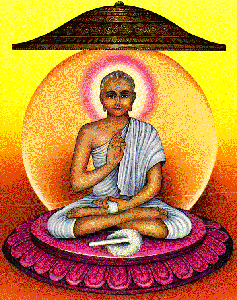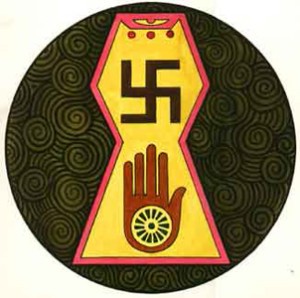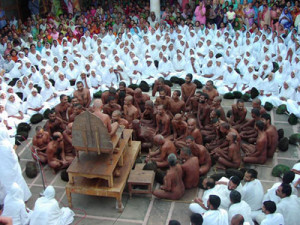Paul Derengowski, ThM
Introduction
One of the more unique non-Christian religions that very few have knowledge or awareness of and is centered mainly in the cities of Ahmadabad, Mumbai, and Calcutta, India is the religion known as Jainism. Totally about four million members worldwide, mainly because of its non-evangelistic outreach, Jainism is not only a Hindu sect, but is contemporary with the beginnings of Buddhism. In fact, because of the close resemblance in upbringing and subsequent religious experiences, between Jainism’s founder (Nataputta Vardhamana aka “Mahavira”) and Siddhartha Guatama (the Buddha), the two are sometimes confused. Nevertheless, there are enough distinctions to also delineate Jainism from Buddhism, as well as Hinduism.
Jainism had its beginning in the sixth-century B.C. when as a man by the name of Mahavira (which means “Great Man” or “Hero”) rejected his early upbringing in a life of luxury and embraced the ascetic life of a wandering monk.[ref]Jacobi questions the actual wealth and power of the family from which Mahavira was reared in his Introduction to the Jaina Sutras. Apparently Mahavira’s father, Siddhârtha, was a “petty chief” of what amounted to a small village (suburb?) where caravans passed by called Kundagrâma. According to Jacobi, “Indeed, though the Gainas fondly imagine Siddhârtha to have been a poweful monarch and depict his royal state in glowing, but typical colours, yet their statements, if stripped of all rhetorical ornaments, bring out the fact that Siddhârtha was but a baron; for he is frequently called merely Kshatriya—…From all this it appears that Siddhârtha was no king, nor even the head of his clan, but in all probability only exercised the degree of authority which in the East usually falls to the share of landowners, especially of those belonging to the recognised aristocracy of the country.” Hermann Georg Jacobi, Jaina Sutras: Part I & II (Forgotten Books, 2008), 3.[/ref] Legend has it that one day Mahavira noticed group of monks in a park outside the town in which he lived (Vaisali), led by the ascetic Parshva. Intrigued by what he saw he proceeded to renounce his previous life, including a wife and daughter, and join the order. He was thirty years old at the time. It would not be for another year, though, until he abandoned all to become an ascetic himself. He waited out of respect for his dying parents, plus he needed to garner his brother’s consent, who wished for him to consider what he was doing to make sure of his decision.
When the time came for Mahavira to join Parshva’s sect, the first thing he did was to pluck five handfuls of hair out both sides of his head, and five handfuls of hair out of his beard as well. He then committed to living the complete life of an ascetic by committing to abusing his body through neglect. This was summarily carried out whether through personal self-abuse and lack of caring for his body, the abuse of other human beings, or by attacks stemming from wild animals. In essence he was making a statement which determined that there was something evil or unclean about the physical body as opposed to that of the spirit; it would be something that the Gnostics would develop in their belief system.
Four distinct characteristics marked Mahavira’s self-asceticism: nakedness, hunger, harmlessness, and inconsistency. Book 1, Lecture 8, Lesson 1 of the Jain Sutras give us a fairly clear picture of the kind of life Mahavira not only lived, but exemplified to his followers to lead:
- As I have heard it, I shall tell how the Venerable Ascetic, exerting himself and meditating, after having entered the order in that winter, wandered about, ‘I shall not cover myself with that robe,’ only in that winter (he used it). He had crossed (the samsâra) for the rest of his life. This (refusing of dress) is in accordance with his doctrine. (1)
- More than four months many sorts of living beings gathered on his body, crawled about it, and caused pain there. (2)
- For a year and a month he did not leave off this robe. Since that time the Venerable One, giving up his robe, was a naked, world-relinquishing, houseless (sage). (3)
- Then he meditated (walking) with his eye fixed on a square space before him of the length of a man. Many people assembled, shocked at the sight; they struck him and cried. (4)
- Knowing (and renouncing) the female sex in mixed gathering places, he meditated, finding his way himself: I do not lead a worldly life. (5)
- Giving up the company of all householders whomsoever, he meditated. Asked, he gave no answer; he went, and did not transgress the right path. (6)
- For some it is not easy (to do what he did), not to answer those who salute; he was beaten with sticks, and struck by sinful people. (7)
- Thoroughly knowing the earth-bodies and water-bodies and fire-bodies and wind-bodies, the lichens, seeds, and sprouts, (11)
- He comprehended that they are, if narrowly inspected, imbued with life, and avoided to injure them, he, the great Hero. (12)
- Practising [sic] the sinless abstinence from killing, he did no acts, neither himself nor with the assistance of others; he to whom women were known as the causes of all sinful acts, he saw (the true state of the world). (16)
- Knowing measure in eating and drinking, he was not desirous of delicious food, nor had he a longing for it. A sage should not rub his eyes nor scratch his body. (19)
- When the cold season has half-way advanced, the houseless, leaving off his robe and stretching out his arms, should wander about, not leaning against a trunk. (21)
- This is the rule which has often been followed by the wise Brâhmana, the Venerable One, who is free from attachment: thus proceed (the monks). Thus I say. (22)
Mahavira’s inconsistency came later when he found that all the gnawing and chewing of the insects which he allowed to crawl all over him got to be a bit too much, especially when it came to the genitalia. So, instead of being totally stark naked, he allowed for a loin clothe to be worn.
To a naked monk the thought occurs: I can bear the pricking of grass, the influence of cold and heat, the stinging of flies and mosquitos [sic]; these and other various painful feelings I can sustain, but I cannot leave off the covering of the privities. Then he may cover his privities with a piece of cloth.
A naked monk who perseveres in this conduct, sustains repeatedly these and other various painful feelings: the grass pricks him, heat and cold attack him, flies and mosquitos [sic] sting him. A naked monk (should be) aspiring to freedom from bonds. Penance suits him. Knowing what the Revered One has declared, one should thoroughly and in all respects conform to it. (1)—Book 1, Lecture 7, Lesson 7.
Mahavira’s association with Parshva was short-lived, and he proceeded to set out on his own, wandering the Indian countryside. Some time afterward, though, he met another naked man by the name of Goshala Makkhali, who was a not only an ascetic as well, but espoused a fatalist doctrine that would eventually result in disputes between them. Separating from Goshala, Mahavira did not associate himself with anyone else, and wandered about for twelve years avoiding people and striving for moksha or deliverance.
Then in his thirteenth year of wandering Mahavira’s mission was accomplished. He attained Nirvana (“Kevala”) while squatting under a blazing sun alongside a river. According to the Kalpa Sutra, “Life of Mahavira, Lecture 5,”
When the Venerable Mahâvîra had become a Gina and Arhat, he was Kevalin, omniscient and comprehending all objects; he knew and saw all conditions of the world, of gods, men, and demons: whence they come, wither they go, whether they are born as men or animals (kyavana) or become gods or hell-beings (upapâda), the ideas, the thoughts of their minds, the food, doings, desires, the open and secret deeds of all the living beings in the whole world; he the Arhat, for whom there is no secret, knew and saw all conditions of all living beings in the world, what they thought, spoke, or did at any moment. (121).
Mahavira then spends the next thirty years of his life gathering followers and teaching them the finer points of his life, doctrine, and experiences. Forty-two years of asceticism as a monk finally end with Mahavira dying at the age of seventy-two. Finally he had been “freed from all pains” and released from this life.
Jain Cosmology or the Loka
- At the top of the cosmos are the varying levels of heaven;
- the top level is occupied by the “liberated souls” (siddhas).
- At the bottom of the cosmos are the eight hells, although none of them are eternal.
- Unless one reaches the top level of heaven, then even those who become “gods” must eventually be reincarnated when their good karma runs out.
- The middle cosmos (Madhya Loka) constitutes the mortal world.
Jain Beliefs & Philosophy
-
Ahimsa: non-injury to anyone or anything.
- Atman: no personal God, just consciousness.
- Bandha: the effect of karma upon a person which results in bondage.
- Karma: a physical substance which attaches itself to a person’s soul.
- Moksha: the liberation of a living being from the physical realm after innumerable karmic effects leading to reincarnation.
- Reincarnation: perpetual recycling of the person’s being until one attains moksha or nirvana.
- Sallekhana: literally means “holy death” by self-starvation.
- Salvation: self-accomplished through extreme asceticism and multiple journeys through the reincarnation cycle.
- Siddhas: those liberated souls at the top of the Jain universe.
- Three Jewels: right belief, right knowledge, right conduct.
- Tirthankara: literally means “ford maker” or “Conqueror;” an enlightened Jina, or which there are only 24, and Mahavira being the last of them.
Five Great Ascetic Vows for Jain Monks
- Thou shalt not kill any living being.
- Thou shalt not lie.
- Thou shalt not take what is not given.
- Thou shalt not have sex.
- Thou shalt not be attached to anything.
- Thou shalt not eat after dark.
Twelve Rules for Jain Laypersons
- Thou shalt not kill any living being.
- Thou shalt not lie.
- Thou shalt not steal.
- Thou shalt not commit adultery.
- Thou shalt not be greedy.
- Thou shalt be tempted through unnecessary travel.
- Thou shalt not be attached to too many daily things.
- Thou shalt not be caught unaware of unnecessary evils.
- Thou shalt maintain a planned period of meditation.
- Thou shalt observe special periods of self-denial.
- Thou shalt commit thyself to occasional days of monk asceticism.
- Thou shalt give monetary support to the monks.
Six Traditionally Approved Occupations for Jains
- Government work
- Author
- Arts & humanities
- Farming (not necessarily ranching, though)
- Craftwork
- Commercial Business
Jain Holy Books
- Originally Mahavira’s teachings meticulously memorized.
- Purvas—Largely non-extant; 14 volumes of Mahavira’s teachings.
- Angas—(“limbs”) or teachings of Mahavira that have been recorded approximately two centuries after his death.
- Upangas—(“lesser limbs”) or a collection of laws & rituals, mainly dealing with assistance in dying, along with a variety of other miscellaneous texts.
Sects of Jainism
- Digambaras—”clothed in sky” or “atmosphere”; total
detachment from everything, including clothing; Mahavira would have belonged to this particular sect of Jainism. - Shvetambaras—”clothed in white”; the liberal branch of Jainism which advocates the wearing of clothing and marriage.
- Sthanakavasis—a relatively new sect of Jainism which advocates devotional worship apart from idols & temples; the nature worshiping sect of Jainism.
- Terapanthis—the reformed sect of Jainism that rejects the use of images, and is guided by a supreme guru.
Jain Logic
- It is centered on relativism: there are no absolutes (which is contradictory in itself, since Jains believe and practice the doctrine of ahimsa, which is the absolute refrain of harming or killing anything or anyone).
- Jain logic implicitly concedes that it is inherently self-refuting, and hence, illogical.




